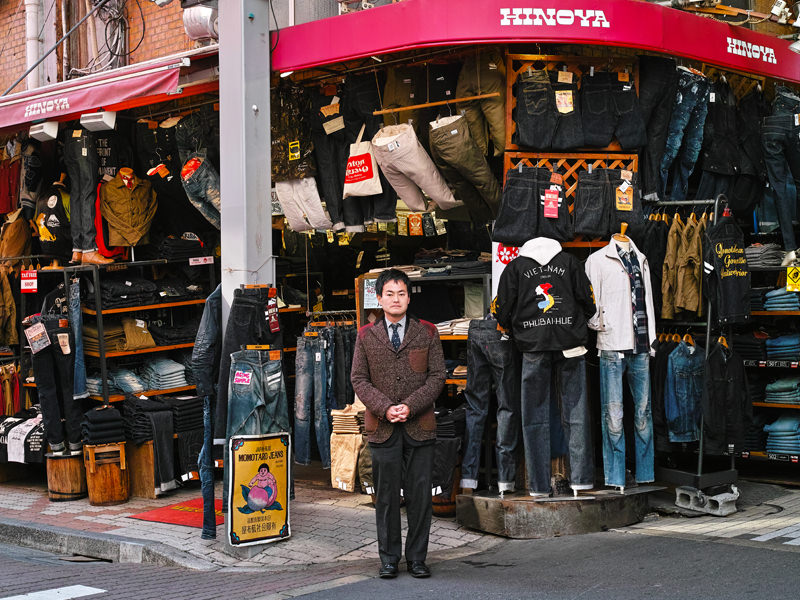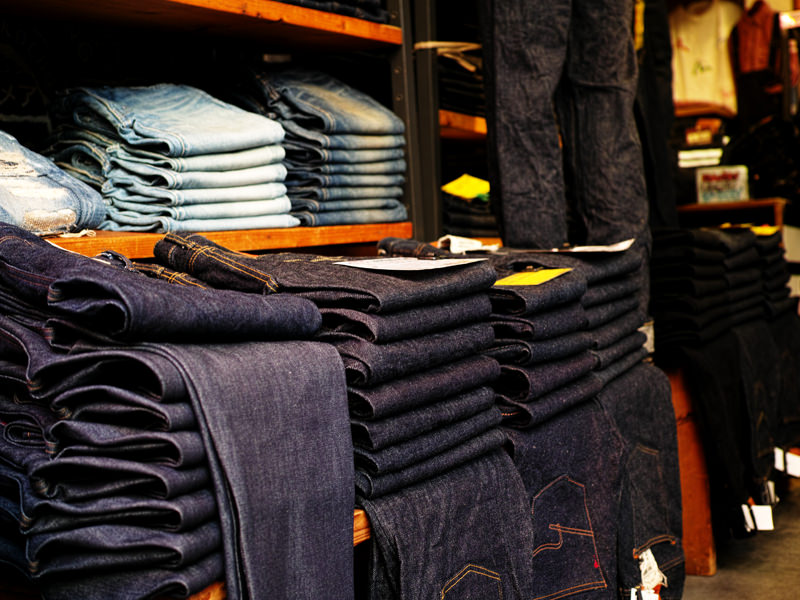Ueno Natives | 上野っ子
新保一洋
Kazuhiro Shimbo


人がアメ横と聞いてまず思い浮かべるのは何百という多種多様な店が迷路のような道にびっしり立ち並ぶ様だろう。
アメ横は上野商店街の中でも最も人気のあるスポットで、掘り出し物を求める世界中からの買い物客で日々賑わっている。
もともとアメ横は戦後の東京に生まれた闇市の一つだった。
人々は暗いうちから警察の朝のパトロールが始まるまでの間、横流し品の売買をしていた。
当時一番の人気商品は飴で、多くの飴売りが店を並べていたことからアメヤ横丁の呼び名が付いたという説がある。
その後、アメリカ軍の払い下げ品が流入し売られたことからアメ横という名前になったという話もある。
物のない時代、ライター、チョコレート、サングラス、化粧品、革製品などの舶来品が人気を博した。
外国の商品で特に人気だったのがジーンズで、幾つかのジーパン屋がアメ横に誕生した。
老舗ジーパン屋の一つであるヒノヤも1955年にアメ横に出店した。
ヒノヤは全ての客にフェアであるためセールは行わないなど、その誠実な商売で時代の荒波を乗り越えてきた。
新保一洋さんは長く続く景気低迷期の中、ヒノヤの三代目として難しい店の舵取りを担っている。
「上野のファッションって認められにくいんです。アメ横のイメージが強いから、ブランドによっては敬遠されちゃう」新保さんはそう説明する。
「僕自身は上野は服が売れるって分かってるんです。実際渋谷とか新宿とかで服が売れてなくても、上野ではちゃんと売れてますからね」
新保さんは早くに上野を離れて30歳になって戻ってくるまで上野の良さについてあまり考えたことがなかった。
「ヒノヤで働くことになってアメ横に戻ってきた時はちょっと戸惑いましたね。もうなんでもありですから。「何なんだ、この町は?」って感じでした」
一言で上野商店街と言っても、実際にはその中に7つの商店街とたくさんの町内会が存在している。
上野で生まれたとは言え、大人になって改めて上野で暮らし始めた新保さんの目にはこの町はとても理解しにくい場所のように思えたのではないだろうか。
「でも」と彼は続ける。
「上野の先輩方が誰もが受け入れられるようなコミュニティの雰囲気作りをしてくださってきたんです。だから何かしらの形で上野に関わってる人だったらウェルカムになるんですよ」
地元の人たちと付き合ううちに、いつの間にか新保さんは上野の色に染められていたという。
「昔はみんな店舗と家が一緒だったから、お店の人の私生活と仕事がごっちゃになってることがよくあったんですよ。僕がお客さんのジーンズで鼻水を拭ってたって親に聞いたことがあります。そういったことは当時の商店では日常茶飯事だったみたいです。アメ横は今もその頃ののんびりした雰囲気を残しているから居心地がいいんだと思います」
この街では気取ったり着飾ったりしないで自分らしくいられるんだと一洋さんは強調する。
「上野の人は本当にみんな気持ちが若いんですよね」新保さんは感心したように話す。
「この前なんて、会合で地元の小学校に行った時、先輩が徒競走やろうぜって言うんですよ、校庭で。ちょっと待ってよって。僕たちもう40代後半ですよ」そう言って彼は愉快そうに笑う。
「この町の飲み会は本当にすごいです。70代の先輩方が未だに飲み比べやってますからね。大盃で一気飲みしたり。飲み会終わったらだいたい何人か潰れてますよね。僕も毎回そんなに飲むのきついんですけど、でも飲み会がとても大事なんですよね、地元の仲間意識にとって」
アメ横では神社のお祭りも大変らしい。
神輿を担いだ人たちが狭い道を人ごみをかき分けながら進んでいくので、毎回けが人が出るという。
新保さん自身も一度その群集の足元に巻き込まれ、肋骨を骨折し肩を脱臼したことがある。
「神輿が自分の頭めがけて突っ込んできたのが見えた時にはアァもう俺死んだなって思いました」そう振り返る。
幸い誰かが新保さんをそこから引きずり出してくれたため、大事には至らなかった。
「毎年お祭りで神輿がアメ横に入ってきたの見えたらみんなちょっと憂鬱な顔になりますもんね」苦笑いしながら新保さんは話す。
「でもやっぱりお祭りって飲み会と一緒で大事なんですよ。一体感が生まれますから。命がけですけどね」
最近は上野に店だけ残して住む場所は外に持つ人が増えている。
上野生まれの子供たちの数は減り、地元の小学校は生徒不足の問題に直面している。
この町はどうやって地元の文化と伝統を未来に引き継いでいくのだろうか。
「上野は人情と商売の町です」新保さんは答える。
「住んでいなくても、上野で商売を続け地元の飲み会やお祭りに参加することで、下町としての良いところをずっと守っていくことができると思います。」
先日地元の小学校では105周年の同窓会が開かれ、下は12歳から上は80代まで100人を超える卒業生が集まったと地元小学校のPTA(正式名称は「育ての会」)会長を務める新保さんは嬉しそうに言う。
世代を超えて、上野っ子たちの地元愛はまだまだ強い。
ファッション業界に携わる新保さんには多様性に溢れる上野のカラーは一体何色に見えるのだろう。
「うーん、赤と青がヒノヤの色だから、赤と青って言いたいところですけど…でも上野の本当の色は透明ですね。酒の色だから」冗談半分、真面目半分にそう言って新保さんは笑った。
When people hear the name Ameyoko market, they usually think of hundreds of miscellaneous shops standing chaotically in a maze-like street.
Ameyoko market is the Ueno shopping district’s most popular spot where so many people from all over the world come to make a good buy every day.
Originally Ameyoko was a postwar black market.
People sold controlled goods through illegal channels from 4 to 7 o’clock in the morning before the police came to patrol.
The most popular item there was candy (“ame” in Japanese), and that was one of the reasons why this market is called Ameyoko (“yoko” is a shorten word for “a street”) today.
Later foreign-made articles sold off by the U.S. Army began to flowed into Ameyoko; this is the other reason of the Market’s name (“ame” is derived from “America”).
Lighters, chocolates, sunglasses, cosmetics, leather products were eye-catchers during the period of shortage of everything.
Among those imported articles jeans were very popular, and pioneers of Japanese jeans shops opened in Ameyoko in those days.
Hinoya is one of those first jeans shops in Japan which started their business in Ameyoko in 1955.
Hinoya has survived the storms of the times with their sincere trade; they do not give a discount in principle in order to be fair to all the customers.
Kazuhiro Shimbo is the third successor to Hinoya who is taking over the helm of Hinoya’s management in this long-time recession era.
“It’s a bit tricky to sell clothing in Ameyoko because of its old image. Some brands still think Ameyoko as a black-market based place, and they don’t want to sell their clothing here,” he explains.
“I personally believe in the business potential of Ueno. Even when business is slow in bigger cities in Tokyo, Ueno sells a lot of clothing every day.”
Kazuhiro had been away from Ueno since he was young, and did not realize true charm of Ueno until he came back to work at Hinoya when he was 30.
“Actually I got confused when I came back to Ameyoko. It was very unorganized here. My impression was “what kind of place is this?””
The Ueno shopping district consists of seven shopping streets and many neighbourhood associations.
Even though he was born there, Ueno might have seemed incomprehensible to his eye when he began to live there again.
“However,” he continues.
“Ueno locals have made efforts toward building good community relationships. No matter who you are and where you are from, you are welcomed to Ueno when you live or work in this town.”
By getting to know the local people, he gradually became imbued with the culture of the Ueno shopping district.
“Traditionally shops here had living space inside, so people’s private life and business were normally mixed. My parents told me that once I wiped my runny nose with customer’s jeans, but it was usual at any shop back then. This shopping district still preserves the warm relaxing atmosphere, and that’s why I feel free and easy here.”
Kazuhiro emphasizes that people do not need to dress and act fancy in this town.
“By the way, all the natives of Ueno are young in spirit,” he says with an amazed look.
“Recently I went to our old school for a meeting. Then one of my seniors there asked me to run a race against him in the school grounds. Come on, we are in our late 40s, not school kids,” he laughs.
“When it comes to our local drinking party, it’s really crazy. Even my great seniors at their 70’s compete each other in drinking in one go with a huge sake cup which is much larger than my face. Always some people pass out after the party. I’m a bit tired of drinking so much every time, but I understand that it is very important to the local community to develop our fellow feeling,” Kazuhiro says.
In Ameyoko, a festival of the local deity is also a hard job.
Because countless people carrying a portable shrine on their shoulders jostle through a big crowd in a narrow street, there are always some people injured.
Kazuhiro himself was once caught in a stampede of the crowd, and broke some ribs and had his shoulder dislocated.
“I thought my time had come when the portable shrine was about to hit my head,” he thinks back.
Luckily somebody pulled him out the stampede and saved him.
“We all become nervous when we see the portable shrine enters the street each time,” giving a sour smile he says.
“But again, the local festivals are very important like our drunk parties. We cultivate a sense of togetherness more than anything with those events.”
“It’s risking our life, though,” he laughs.
Nowadays quite a few shop owners move out from the Ueno shopping district while they keep their shops there.
The number of Ueno-born children is getting lesser, a local elementary school is facing a shortage of pupils.
How will this town maintain its culture and tradition in the future?
“This town stays based on the warm fellow feeling and merchant behavior,” Kazuhiro answers.
“As long as people continue their business here, and get together for drinking and festivals, we are able to keep our culture and tradition alive for a long time.”
The local elementary school just had its 105th alumni meeting, and more than 100 former students from 12 year-old new graduates to seniors at their 80s gathered.
It seems that a sense of belonging among the locals remains strong.
As a fashion retailer, what color does Kazuhiro see as an image of the Ueno shopping district?
“Well, red and blue are Hinoya’s symbol colors, so I would like to say red and blue. But honestly, Ueno’s colour is transparent just like sake (rice wine),” so saying half-joking and half-serious Kazuhiro laughed.
